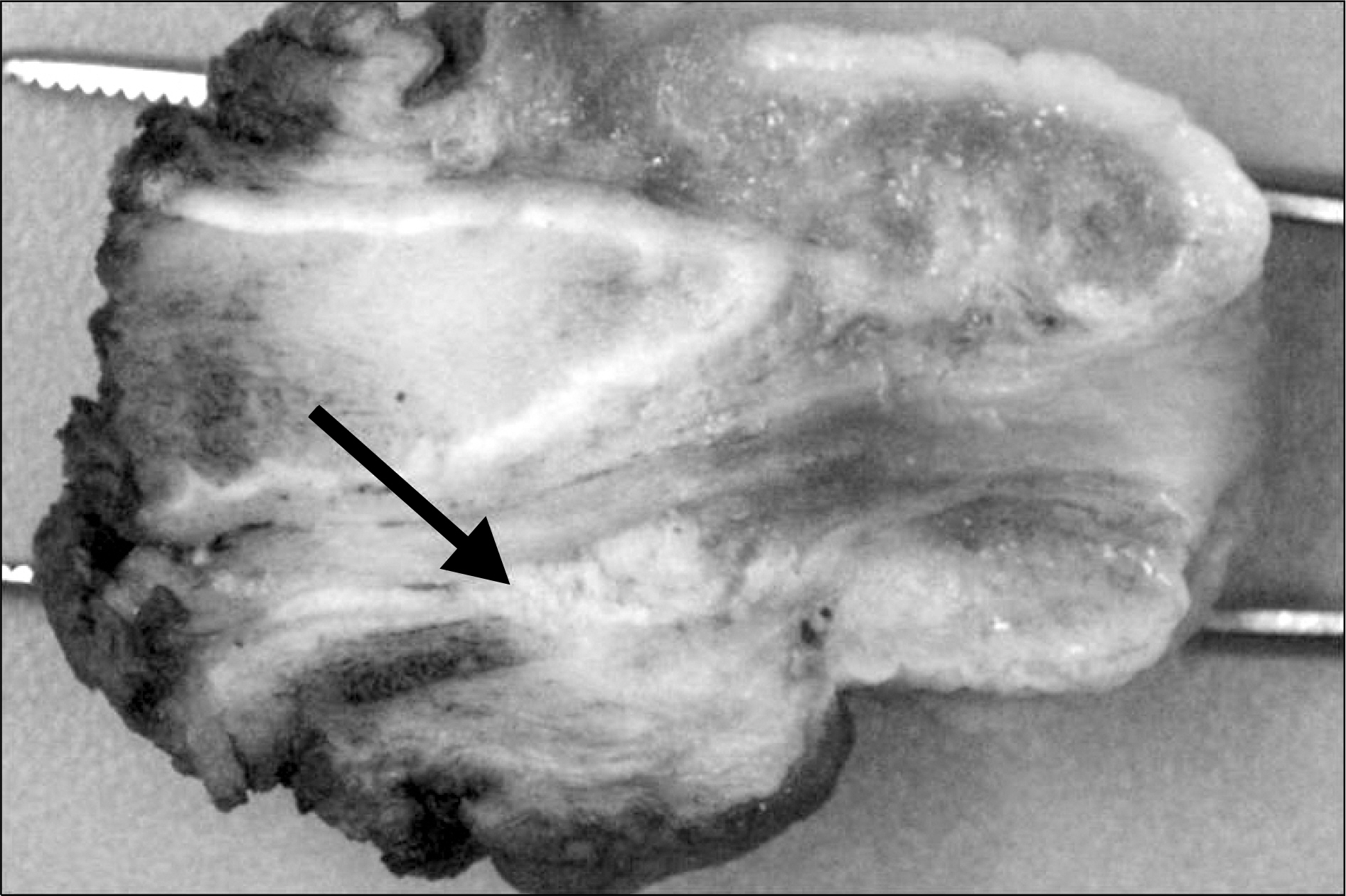Korean J Androl.
2011 Apr;29(1):88-90. 10.5534/kja.2011.29.1.88.
Penile Squamous Cell Carcinoma Diagnosed following Treatment of Urethrocutaneous Fistula after CO2 Laser Therapy for Misdiagnosed Penile Lesion: Report of a Case
- Affiliations
-
- 1Department of Urology, Jeju National University School of Medicine, Jeju, Korea. urohjs@jejunu.ac.kr
- 2Department of Family Medicine, Jeju National University School of Medicine, Jeju, Korea.
- 3Department of Pathology, Jeju National University School of Medicine, Jeju, Korea.
- KMID: 2298631
- DOI: http://doi.org/10.5534/kja.2011.29.1.88
Abstract
- The complications of the treatment of penile lesion are wide ranging, urethrocutaneous fistula being one of the less common. This complication affects the ventral aspect of the penis. We present a rare case of urethrocutaneous fistula after vaporization of penile lesion by CO2 Laser. One fistula was at ventral aspect of the penis. A 43-year-old male presented with passage of urine from one opening. He had undergone a vaporization by CO2 laser, 2 times. Urethrocutaneous fistula repairs was performed with biopsy of the edge of fistula site. Squamous cell carcinoma was confirmed. He subsequently underwent a partial penectomy. It is very important that biopsy was performed before vaporization of even small size skin lesion. This case is reported along with a brief review of the literature.
Keyword
MeSH Terms
Figure
Reference
-
1). Barnholtz-Sloan JS, Maldonado JL, Pow-sang J, Giuliano AR. Incidence trends in primary malignant penile cancer. Urol Oncol. 2007; 25:361–7.
Article2). Misra S, Chaturvedi A, Misra NC. Penile carcinoma: a challenge for the developing world. Lancet Oncol. 2004; 5:240–7.
Article3). Favorito LA, Nardi AC, Ronalsa M, Zequi SC, Sampaio FJ, Glina S. Epidemiologic study on penile cancer in Brazil. Int Braz J Urol. 2008; 34:587–91. discussion 591-3.
Article4). Daling JR, Madeleine MM, Johnson LG, Schwartz SM, Shera KA, Wurscher MA, et al. Penile cancer: importance of circumcision, human papillomavirus and smoking in in situ and invasive disease. Int J Cancer. 2005; 116:606–16.5). Paoli J, Ternesten Bratel A, Löwhagen GB, Stenquist B, Forslund O, Wennberg AM. Penile intraepithelial neoplasia: results of photodynamic therapy. Acta Derm Venereol. 2006; 86:418–21.
Article6). Schroeder TL, Sengelmann RD. Squamous cell carcinoma in situ of the penis successfully treated with imiquimod 5% cream. J Am Acad Dermatol. 2002; 46:545–8.
Article7). Michelman FA, Filho AC, Moraes AM. Verrucous carcinoma of the penis treated with cryosurgery. J Urol. 2002; 168:1096–7.
Article8). Tewari M, Kumar M, Shukla HS. Nd: YAG laser treatment of early stage carcinoma of the penis preserves form and function of penis. Asian J Surg. 2007; 30:126–30.9). Leijite JA, Kirrander P, Antonini N, Whndahl T, Horenblas S. Recurrence patterns of squamous cell carcinoma of the penis: recommendations for follow-up based on a two-centre analysis of 700 patients. Eur Urol. 2008; 54:161–8.10). Stein BS, Kendall AR. The use of the Nd: YAG laser in urology. Lasers Surg Med. 1985; 5:129–32.
- Full Text Links
- Actions
-
Cited
- CITED
-
- Close
- Share
- Similar articles
-
- A Case of Congenital Urethrocutaneous Fistula
- Penile Dorsal Skin Flap Urethroplasty in Extensive Traumatic Urethral Stricture
- A Case of Verrucous Carcinoma Arising in Penile Lichen Sclerosus et Atrophicus
- Synchronous Verrucous Carcinoma and Squamous Cell Carcinoma of Penis by Different Human Papillomavirus Infections
- Secondary penile carcinoma originated from pancreas




